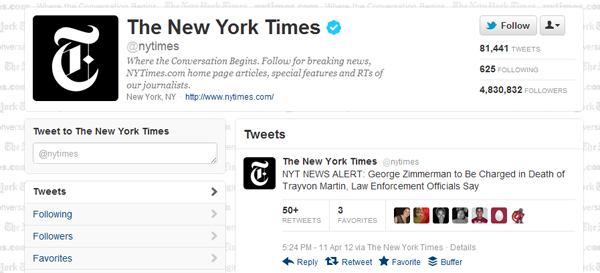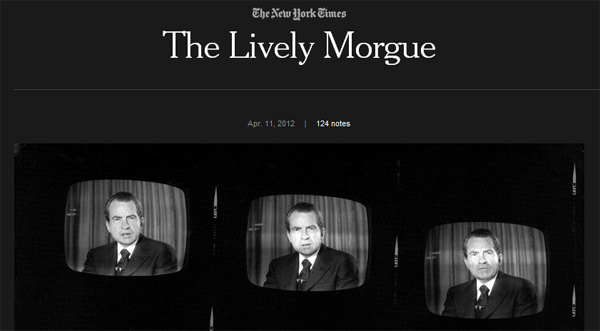Share
How The New York Times Does Social Media
To think that it’s impossible to draw any parallels between your photography business and The New York Times is to be shortsighted. What makes ...

To think that it’s impossible to draw any parallels between your photography business and The New York Times is to be shortsighted. What makes or breaks your business these days is whether you stand out from the crowd, and both you and NY Times need to connect with customers on a personal level in order to do so. More importantly, both have to hang out where their audience is.
That’s where social media comes into play. It’s the one place where all brands, no matter how big or small, can have a voice and engage with their community. We continue to tout the importance of social media in driving traffic to your website and building a reputation for your photography brand. (Recall that the aggregate of PhotoShelter members see roughly 22% of their sites’ traffic come from social media.)
So what can you learn from a big shot like The New York Times? Turns out that serious social media strategizing is relatively new for this news publication. I talked with Alexis Mainland, social media editor at The NY Times, to learn more about their vision for solidifying The Times’ brand over several different platforms, and how photography has played a major role in their success. The major takeaway? Listen to the community before your speak.
What is your role at The New York Times and how long have you been there?
I’m the social media editor at The Times, a role I’ve had for a little over a year. I’ve been working here for almost six years, four of which I spent on the Metro desk working as a multimedia journalist. The Times has had a social media editor since the spring of 2009. In the winter of 2010-2011, Liz Heron and I became co-editors of social media, and now Liz has moved on to running social media and engagement at the Wall Street Journal.
What are your day-to-day tasks as social media editor?
At The Times, social media editing is primarily focused on these areas:
- Developing the whole institution’s overall social media strategy and sensibility.
- Imbuing our breaking news and major event coverage with innovative social elements.
- Working across the newsroom to train journalists on best practices for social.
- Collaborating with individual news desks on social-oriented journalism projects.
What’s the general social media strategy at The Times, and how did you choose which platforms to focus on?
Social media is a key newsgathering medium for us too, but our strategy in distributing our content via social media is to be as engaging as we can, as creative as we can, and to generate as robust of a conversation around our journalism as we can. Wherever possible, we also try to produce something of journalistic value out of our activities on social media, something that provides an additional window or angle on a topic or story.
What kind of role does photography play on The Times‘ social media?
I think photography plays a huge role in social media at The Times. The cliche that a picture is worth 1,000 words rings especially true on social media sites. On Tumblr (we have two: The Lively Morgue and T Magazine on Tumblr), our projects are based around imagery. And we regularly find that images we share on Facebook are more popular and engaging than text. Our Facebook page, especially now that it’s using Timeline, can display images to dramatic effect.
Apparently there is a very strong amateur and professional photography contingent on Google+ that we hope to tap into. We’re also developing a strategy based around photos for Pinterest. And we have a popular Instagram feed, @nytimesfashion, devoted to all things stylish. It’s also really fun to see more and more Times reporters and photographers sharing photographs from the field on Twitter, Facebook and Tumblr. A real-time photo from the campaign trail or from the site of a protest can sometimes telegraph the story in the most compelling way.
How do you determine what content is “shareable?” The Times publishes so many stories, there must be a ton to select from every day!
It really depends on the platform. But we try to keep an eye on what stories are resonating on social media or with our commenters on nytimes.com. Stories about social media tend to encourage a lot of sharing, as do personal stories, major investigative pieces or exclusives, breaking news and stories about health and lifestyle.
You’re right about the volume of stories we publish. It’s something like 150 articles a day – and that doesn’t include slide shows and other multimedia – so part of determining what to share is about finding those gems that might not have been on the homepage or on the front page, but are made for social media. It’s great to have an additional outlet besides the main site’s homepage and front page for sharing great content.
How does your strategy differ from platform to platform? Is there a plan of attack for the different demographics on each site?
Social media platforms are like different countries with different languages and different customs. Certainly there are many aspects of them that overlap, but I think the key to being successful on a social platform is having a keen understanding of what makes each unique community tick.
For instance, Tumblr thrives on strong visual material; Reddit is great for its crowd-sourced Q & A capabilities; Twitter is an essential platform for news and events, etc. Our institutional Twitter feeds are less likely to retweet outside sources, but there are over 440 Times journalists on Twitter, and they share and retweet tons of material that’s not from The Times.
How do you see social media helping The Times‘ business grow?
Personally, I’m approaching social media for The Times from a purely journalistic point of view. We’re fortunate to have many smart people thinking about the business angles of what we’re doing. However, I think being as excellent as we can be on social networks can only help our business. And social media is also crucial to opening up The Times to new voices that we benefit from listening to, and allows us to reach new audiences that may not engage with us through our website or newspaper, but do participate in the social conversation. Being more open, connecting with our audience and expanding our reach – virtually and internationally – is good for the business.
Is your team concerned about brand diffusion by taking the stories off nytimes.com?
We look for ways to express the values of The Times on all the social platforms we’re active on. For example, we recently launched our New York Times Facebook timeline page, where we’ve posted dozens of archival photographs going back to our founding in 1851. While those images are published off of nytimes.com, our Facebook page is really an extension of our brand, not a diffusion of it. The images we’re featuring there were carefully researched, the captions and dates were thoroughly reported. We work to make whatever we post there every day as compelling as possible. With our new Tumblr, The Lively Morgue, we’re thrilled to be sharing our photographic treasures on a platform that makes discovery and sharing so much fun.
You can connect with Alexis on Twitter @lexinyt and see what The Times is up to @nytimes.





